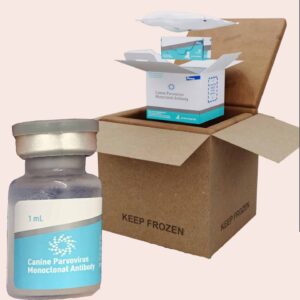Parvovirus Infection In Your Dog
Parvo Virus Enteritis – CPV
Ron Hines DVM PhD
Parvovirus is the most common dangerous viral disease affecting dogs in the developed world. Until ~1978, that title was held by the canine distemper virus. Parvovirus is extremely contagious. While the distemper virus dies rapidly in the outside environment, the parvovirus is very stable. Canine parvovirus is capable of retaining its infectivity for many months (some says up to 2 years) when given the right conditions.
The parvovirus is a tough organism in other ways. Unlike the distemper virus, parvovirus is resistant to many common disinfectants. Drying and hot days (up to 80 C/176 F for 30 minutes) will not reliably kill it. The virus is resistant to cold temperatures and acidic environments as well. Parvovirus has a very successful infection strategy. It directly attacks specific cells of your dog’s immune system – the very cells responsible for your dog’s protection against virus. A third troubling ability of the parvovirus is its capacity to “reinvent” itself from time to time through its high rate of mutation. It also has the ability to merge with other strains of parvovirus when it encounters them in the body. Parvovirus is a relatively new threat to dogs. Cats have always been plagued by their own parvovirus, the one that causes panleukopenia. Some time in the 1960s or 1970s, the cat parvovirus managed to mutate just enough to infect dogs.
Parvovirus is a particularly devastating disease in puppies and adolescent dogs. The younger the dog, the more likely that symptoms will be severe. Luckily, the vaccines veterinarians have, are very effective and give long-lasting immunity against parvo. However, the age at which parvovirus-containing vaccines are given is very important to their effectiveness. (read here)
If My Dog Catches Parvo, What Signs Might I See?
A favorite location for the parvovirus is within the patches of immune cells scattered throughout the walls of your dog’s upper intestines. (read here) There, the parvovirus causes severe damage, both directly and by killing the resident lymphocyte cells crucial in preventing pathogenic bacteria from invading your pet’s intestinal walls (located in the Peyer’s patches). Not surprisingly, starting 3–5 days after infection, great numbers of the parvovirus begin to pass out in the dog’s stool. Parvovirus can continue to be shed in a dog’s stool for at least a month. (read here)
Very young puppies are a special case. The parvo virus has a preference for cells within a dog that are rapidly dividing. In very young puppies, those cells are not just the rapidly dividing lymphocytes, but also the cells of their developing heart. So young infected puppies often die rapidly from heart failure. Others survive but are left with their heart function permanently impaired. The signs you are more likely to see in older puppies, adolescent or mature dogs relate to what is going on in its intestines. Those signs generally begin 3-5 days after exposure to the parvovirus. Some say as early as 2 days and as long as 14 days after exposure, but I have never encountered those extremes. The earliest signs are depression and a disinterest in food. They might approach their food and water dishes halfheartedly to sniff now and then, but the progressing inflammation of their intestines has taken away their appetite. That is soon followed by vomiting and diarrhea. The diarrhea produced has a distinctive foul odor and the chocolate color of digested blood. Some associate the newer CPV2c strain of virus with less of the traditional parvo stool odor and color. Both the vomiting and diarrhea cause dehydration that adds to the dog’s depressed, dull state. Occasionally, early fever plays a part in the dehydration as well. Dehydration leads to the loss of ability of plucked up skin to bounce back. It assumes a doughy, clay-like consistency that your veterinarian will notice. That, and the sunken eyes of illness (cachexia), often lead to a build up of material at the inner corners (medial canthus) of their eyes. Any form of dehydration will do that.
Fever is only common during the first few days of illness. That, and occasional anemia resulting from intestinal blood loss, can cause rapid respiration and heart rate (tachypnea/tachycardia). In the early and middle stages of serious parvovirus cases, affected dogs’ abdomens are often tight and tucked in. If you gently push or knead the tummies of these dogs, it is often quite obvious that it is painful to them. For unknown reasons, certain breeds appear more susceptible to severe parvovirus disease. Those breeds include rottweilers, pit bulls, pinschers, spaniels and German shepherds. The tendency of some breeds to have more blood clotting issues than others might be a factor. Later in the disease, a weak pulse, subnormal temperature and other signs of shock often accompany severe cases. Many associate that with the toxins, produced by invading secondary bacteria, circulating throughout the animal’s body. (read here) With the dog’s immune system disabled and the intestinal lining partially destroyed and “leaking”, bacteria normally confined to the intestines now have free passage into the rest of the body.
Parvovirus disease can be a downward roller coaster ride with a bottom that veterinarians cannot accurately predict. The depth of that bottom depends on your dog’s age, its general health, the number and strain of the parvovirus involved and, importantly, any partial immunity it acquired from its dame that still persists in its bloodstream. In puppies that are still nursing, some vets theorize that high levels of anti-parvo antibodies in their mother’s milk protect locally in the pup’s intestine against parvo virus penetration – even after the window for colostral antibody absorption has closed. Survival is also highly dependent on the veterinary care that your dog receives. That care will hopefully give their bodies’ immune system time to bounce back and produce its own antibodies that neutralize the parvovirus. No medicine veterinarians have can disable or kill the parvovirus. I have noticed that dogs that look no worse for two days in a row almost always survive when supportive medications, fluids and good nursing care are provided.
There are many dogs, particularly small puppies, who do not survive this initial phase. Their body reserves are just too limited to battle the virus. Some actually die before the diarrhea begins. Other things being equal, the severity, and outcome of parvovirus infections has a lot to do with the age of the dog involved. Healthy adult dogs that become infected can show few if any symptoms at all. Infected puppies, that are fortunate, still retain some of their mother’s antibodies that lessen the chances of their infection being fatal.
Not all cases of severe diarrhea with parvo-like symptoms are caused by the parvovirus. Coronavirus of dogs, although rarely fatal, can cause similar initial signs. So can hookworms, bacteria and dietary indiscretions. Read about that here
What Tests Might My Veterinarian Run?
With increasing experience, veterinarians learn to recognize likely cases of parvo. At one time, that was done only through your veterinarian’s physical examination, the history you provided (= “signalment”, the age, breed, vaccination status, home environment, of your dog). Parvovirus tended to cross the minds of all veterinarians whenever a young dog was brought in with vomiting, diarrhea, depression and a spotty vaccination history. But today, the linchpin for a positive parvovirus diagnosis are any of the in-office tests that confirm the presence of the parvovirus itself.
Your veterinarians will often notice other things abnormal in your dog’s blood work too: Early in parvo disease, all or major potions of your dog’s white blood cell count are often low (= leukopenia, neutropenia, lymphopenia). (read here) Throughout the disease in severe cases, liver enzymes are often elevated as well. The blood ions: sodium, potassium, chloride and bicarbonate, are often out of balance. When substantial damage has already occurred to your pet’s intestinal lining, it begins to leak vital blood proteins. So, your dog’s blood albumin, and blood globulin are often low as well. Parvovirus’ damage can even extend to your dog’s pancreas. When it does, its blood level of pancreatic enzymes might be elevated as well. (read here)
The Newer Office Tests That Identify Parvo
These tests all use specially designed ELISA assays that search for parvovirus in your dog’s stool. If these tests fail to catch a parvovirus case, it is usually because it is still too early or too late in the infection for enough of the virus to be present. Your veterinarian can run these tests in about in 8-10 minutes. As I mentioned, the tests are not foolproof. As I mentioned, they can yield falsely negative results early in infections when parvovirus numbers are still low or late in infections when most virus have already been eliminated. Some say that watery stools are more likely to give false-negative results. But I do not know if that is true. There are mixed opinions as to whether recently administered parvovirus-containing vaccinations produce false-positive test results. I tend to believe that they sometimes do.
Veterinarians also have the ability to order more sophisticated PCR tests on samples of your dog’s stool. These tests are more accurate because they amplify and detect the presence of even very small amounts of parvovirus’ DNA. But they all require that the fecal samples from your dog be sent to a laboratory that specializes in performing the complicated test. So, it takes much longer to get your dog’s test results back – often too long to wait before begin treatment. PCR tests also cost more. And even PCR tests can have difficulty deciding if the virus DNA present is from a recent vaccination or due to a “wild” pathogenic strain of parvovirus. (read here) We know that dogs can harbor and shed vaccine-origin parvovirus for at least 28 days after being vaccinated. (read here) When either test returns unexpected results, many veterinarians glance back at your dog’s neutrophil count. Wild strains of parvovirus usually depress a dog’s neutrophil count early in the disease – firming up your veterinarian’s diagnosis decision.
Veterinarians can also look for a rise in anti-parvo antibodies in your dog’s blood. That stead rise in anti-parvo antibody titer occurs in dogs that are successfully recovering from a parvovirus infection. Since this method requires early-in-the-disease and later-in-the-disease blood sample comparison, they are of no help in making immediate diagnosis and treatment decisions when your dog is in trouble. However, a high parvo antibody titer found in a sick dog at admission would make your veterinarian think twice about a diagnosis of parvo. High antibody titer dogs should have been immune.
What Treatment Might Help My Dog?
Veterinarians do not have any medications that kill parvovirus once they are inside your dog’s body. What your veterinarian can offer your dog is supportive care.
1. Dehydration is a common finding in severe parvovirus cases. And significant (5-10% or more) dehydration affects your dog’s ability to keep its crucial blood electrolytes in normal balance. (read here). Dehydration also lowers the volume of blood your dog has available to transport nutrients throughout its body and to eliminate waste from its organs. So, replacement fluid injection (IV fluids such as LRS) that contain replacement electrolytes as well as water are one of the key element of supportive care in parvovirus treatment. Additional ingredients are often added to those fluids before they are administered. Things like bicarbonate to bring your pet’s acid:base balance back into the normal range, glucose for dogs whose blood sugar has dropped dangerously low or potassium for those with hypokalemia. (read here)
2. Also, very important is to include one or more antibiotic barriers to defend your dog against secondary bacterial invaders while we all wait for your dog’s own immune system to activate and produce antibodies that destroy the parvovirus. Antibiotics such as cefovecin/Convenia® or cefoxitin are frequently given. Ampicillin and second and third generation cephalosporins are still safe alternative antibiotics for dogs fighting parvo. Aminoglycoside antibiotics such as gentamycin can cause kidney and other damage in dehydrated patients. When bacteria that thrive without oxygen are suspected, metronidazole is occasionally administered. (read here) Unfortunately, the antibiotics given to these dogs to save their lives kill the good as well as the bad bacteria. That can results in other opportunistic bacteria eventually taking their place (dysbiosis). One study found that fecal bacterial transplants (FMTs) from a healthy dog seemed to improve that problem. (read here)
3. Temperature control is also quite important. Fever is only present early in parvovirus disease. It is rarely ever present in young puppies who have contracted parvo. It is more likely that your dog will need body temperature support. If your pet’s temperature drops to subnormal levels (hypothermia) it needs to be raised. No system or organ in a dog’s body, including its immune system, functions well when it is chilled.
4. Your veterinarian will do as much as possible to decrease the inclination your dog to vomit. Medications to do so include drugs that work directly to suppress vomit-inducing centers in the brain (antiemetics such as maropitant/Cerenia®, metoclopramide and perhaps ondansetron/Zofran®) (read here)
5. Medications that coat the lining of your dog’s stomach and intestines (gastroprotectants such as sucralfate/Carafate®) can be helpful
6. If parasite eggs (particularly blood-sucking hookworms) are found in your dog’s stool, gentle wormers such as pyrantel/StrongidT® might be indicated as well. It is not uncommon for young dogs suffering from the nausea of a parvovirus infection to experience a situation where their intestine propels its contents in the wrong direction (reverse peristalsis). So, I often find mature roundworms in the vomit contents of parvo-infected dogs.
7. Parvovirus enteritis is a painful disease. The most common drug used today to counteract the abdominal pain associated with parvovirus is probably buprenorphine. Some believe that Flunixin/Banamine®, used to reduce post-surgical pain in dogs, can actually make parvo-related intestinal and stomach problems worse. (read here)
Dogs with milder cases of parvo infection can often be coaxed to accept small amounts of liquid or liquefied diets and gels (e.g. NutriCal®, Lixotinic®, Virbac Rebound®, R.C. Recovery® or Purina CN®), given at frequent intervals. At one time, veterinarians were taught that dogs with parvovirus infections should not receive any food by mouth because their intestines needed a “rest period”. But most now feel that small, frequent feedings of these products might improve your dog’s chances of survival. We really do not know. If your dog will not lap up the product after a drop or two is placed in its mouth and given a little coaxing, I would discontinue the attempts for now.
Using those medications and procedures, veterinarians can usually save ~70-85% of the parvovirus-infected dogs that arrive. Those that are the hardest to save are the fragile young puppies that are so susceptible to shock and sudden death. But if they can make it through the first three or four days, even many of those do recover. Some are left with long-term disabilities such as heart damage and intestinal maldigestion/ malabsorption issues that make it difficult for them to maintain normal body weight throughout life. (read here & here)
Once your dog has been stabilized by your veterinarian, it is possible to treat many cases of parvovirus in your own home while under your veterinarian’s staff supervision. Not everyone has the temperament to do that. It can be a very labor-intensive and emotionally draining process. But when done well, it can mean the difference between life and death when economics or circumstance do not permit you to opt for a longer in-hospital stay. Once your dog is stabilized, obliging veterinarian technicians can teach you how to give fluids subcutaneously and how to monitor your pet’s vital signs. Not all veterinary clinics have rules that allow that. When done right, success rates for at home treatment are high – but probably never quite as high as good in-hospital care.
There was a time when veterinarians though that a transfusion of blood serum, obtained from a dog that had recovered from parvovirus, might help save the life of a parvo-infected dog. I had many successes doing that when young puppies arrived with a serious parvo infection. I kept a blood donor and hospital pet Labrador retriever at my animal hospital where repeated contact and high immunity to the parvovirus was likely. Studies confirm that such hyperimmune serum might conceivably be beneficial. (read here, & here)
Why Is Parvo Treatment So Expensive?
Many dog owners are flabbergasted at the current cost of parvovirus intensive care. It is easy to assume that the hospital staff pockets that money. That is never the case. The current cost of a 10 ml bottle of Zoetis’ Convenia® antibiotic in the United States as I write this article is $359.45 plus shipping. Once reconstituted, I have to discard the refrigerated remainder after 56 days.
Can My Dog Catch Parvo More Than Once?
I have never seen nor heard of that happening. A dog that has recovered from a confirmed parvovirus infection is believed to be immune for the rest of its life.
How Long Should I Wait Before Bringing Home Another Dog?
It is considerably easier to make your new dog immune to parvo than it is to clean up a parvo-contaminated environment. If your vets could not save your dog, wait a few months before considering purchasing or adopting another dog. Your whole family needs to come to terms with the loss of the pet. If you long for immediate companionship, consider fostering an adult (solidly vaccinated) dog from a rescue group.
What About The Parvo Cures I See For Sale On The Internet?
Some internet sites suggest vitamins, probiotics, prebiotics, glucosamine, various homeopathic remedies, acupuncture and other dubious treatments will cure your dog of a canine parvovirus infection. None of that has ever been proven to be the least bit helpful. When, in desperation, you purchase those items online, in pet stores, or at clinics, at best, they will cause your dog no harm. (read here)
I Know About All Those Worthless Products, But Are There Any New Legitimate Products To Treat Parvo?
Yes.
You remember that I mentioned that during a puppy’s first ~10 – 14 weeks, it is protected against the parvo virus by its mother’s immunity (provided she was vaccinated or exposed to parvo herself) In May of 2023, the USDA gave conditional approval to Elanco to market an artificial monoclonal antibody that destroys the parvo virus. Attending a lecture in June, I learned from the Elanco representative that the medication is still in short supply and that it is quite expensive for them to manufacture. They hope that manufacturing costs will decrease with time as they gain more experience producing it. To learn who currently has access to this medication, ask Elanco’s product development group.
You are on the Vetspace animal health website
Visiting the products that you see displayed on this website help pay the cost of keeping these articles on the Internet.






